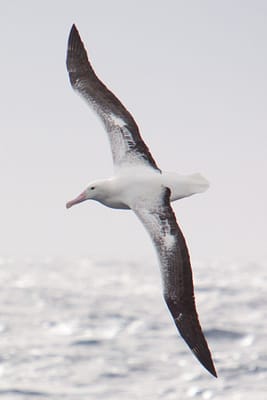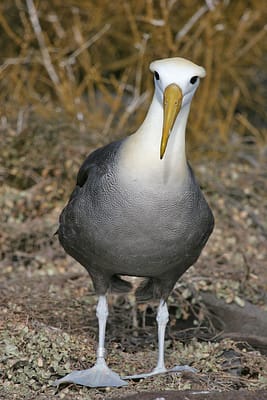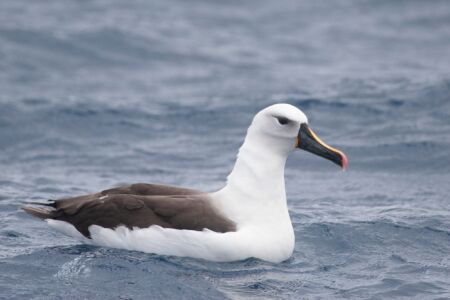
World Albatross Day 2020
Jun 19, 2020 | by Alex Lamoreaux

Southern Royal Albatross, photo by Kevin Loughlin
A boat trip on the open ocean is like visiting a new world. Deep blue water surrounds you as far as the eye can see. Invisible to us, but filling the water below, are thousands of fish and other marine life. The huge, smooth back of a whale breaks the surface of the choppy sea. Shearwaters zip around like the most skilled of pilots; rising up and banking away over the crest of a wave. Tiny, black storm-petrels gather in choreographed flocks to dance on the water. As mere humans, we stand – unsteadily – along the railing of the ship and stare with amazement at these sights. We try our hardest to keep our glasses and binoculars clean of spray, and eagerly await the next sighting…
Over the churring of the engines someone’s muffled voice yells out, and all attention is directed to where they are pointing. On the horizon there are massive, slender wings angled toward us. These are the wings of an albatross! Even if you’ve never seen one before, these behemoths are unmistakable. Each slow, powerful wingbeat draws the bird closer until it sets into a slow glide and passes right by the ship. You lock onto it’s huge, black eyes and can’t help but feel like the mighty bird isn’t nearly as impressed with you. Sure enough, those eyes have seen a lot. Some albatross have been known to live well over 60 years; traveling the seas for months on end.
Wildside Nature Tours joins the Agreement on the Conservation of Albatross & Petrels to celebrate the first annual ‘World Albatross Day’ today, June 19th! The experiences we’ve had with albatross, either on the open ocean or sitting nearby as they tenderly care for their nestlings, have been some of the most special moments we’ve shared with our guests over the years. We couldn’t imagine a world without these incredible creatures, and they need our help and attention now more than ever. Thousands of albatross and other seabirds die each year due to plastics pollution and notably long-line and trawling fisheries operations. Please visit the ACAP website to learn more about how you can help albatross and seabird conservation efforts; watch the excellent videos, lectures, and interviews that the Albatross Task Force has posted on Youtube; and enjoy the snippets below about our guide’s favorite moments with albatross on a few of our tours! There are currently 24 recognized species of albatross across the world’s oceans, and our tours have tallied 11 species so far. Here’s a little tribute to the big ol’ birds, and we hope to see them out there for decades to come! Happy World Albatross Day!

Shy Albatross offshore South Africa, photo by Adrian Binns
Hawai’i

Laysan Albatross, photo by Chris Brown
We visit the islands of Hawai’i each spring and fall and one of the many highlights of these trips is being able to see nesting Laysan Albatross on Kaua’i. We have also seen Black-footed Albatross during pelagic trips out of Kona. Laysan Albatross may sound familiar to you because an individual of this species – a female aptly named ‘Wisdom‘ – is the oldest banded bird on earth, currently 66 years old and still returning to nest on Midway Atoll in the Pacific! The Hawaiian word for albatross is ‘moli‘ and interestingly, this is also their word for tattooing tools which historically were made out of albatross bones!
“Their surroundings may have changed over the centuries but that doesn’t stop the wondrous Laysan Albatrosses from returning to their ancient nesting grounds on Kaua’i – and just in time for our March Hawai’i tour! While some pairs of these gentle giants nest closer to the cliff faces, most nest right in the subdivisions and golf courses which have encroached upon their home.” – Chris Brown
Antarctica
Many of us can look out the windows of our homes right now and see a robin dutifully picking through the grass for a worm to take back to its eager nestlings. These songbirds may have territories encompassing a few acres in size. Albatross live their lives on a totally different scale. Indeed, some albatross species can travel over 600 miles in a single day while on foraging jaunts to then return to feed their nestlings on small tropical islands scattered throughout the globe. The rich seas surrounding Antarctica are the foraging grounds for many of the world’s albatross species, and Kevin’s trips there have had some remarkable moments.
“On our first trip to Antarctica in 2010, we had amazing weather coming back across the Drake Passage. The birds were spectacular! Albatross were abundant! Wandering, Black-browed, Northern Royal and Southern Royal, Light-mantled Sooty, and Gray-headed Albatross all showed off nicely for photos, and I missed the shot of our only Yellow-nosed Albatross sighting. Imagine; I’ve still never been on a ‘real’ pelagic trip!” – Kevin Loughlin
Galapagos Islands

Waved Albatross on the Galapagos Islands, photo by Adrian Binns
Even after thirty visits, Kevin looks forward to each and every Galapagos tour he organizes alongside wonderful guest leaders. Each visit offers more to learn, and you can always finds new photography opportunities while exploring these storied islands. Perhaps the most sought-after photo moments on our trips are when we visit a colony of Waved Albatross and are able to witness them dancing and knocking their huge yellow bills together! Waved Albatross are also known as ‘Galapagos Albatross’, and like many other seabirds, they mate for life. Historically, the grazing foraging style of the massive Galapagos Tortoises would clear away patches of vegetation and offer albatrosses with large open areas to nest in. Sadly, the decline of tortoises on these islands has made it harder for the albatrosses to find suitable nesting sites, and many young birds can become tangled in dense brush. It’s amazing to consider the connection that these epic wanderers have with a tortoise so utterly stuck on dry land!
“After lunch we sailed around to the southwestern tip of Espanola at Punta Suarez and spent a marvelous 3 hours walking the short, rocky boulder-lined path around the tip. At the end of the trail was a blowhole. When water rushed under the bedrock, spray would spout into the air. Due to low tide, the blowhole did not produce the much-hoped for 100 foot spray, but nevertheless it was impressive; especially when we were graced with a Waved Albatross gliding past! Back toward our boat we came across a pair of albatross displaying in the middle of the path. Only feet from away, we watched in awe as they began to duel with their bills, lift their heads up (sky-pointing), and drop them down again in a split-second. Occasionally they would open their bills wide instead of sky-pointing. The show went on and on. Although they had pretty much completed nesting for this season, this behavior was part of their pair bonding routine.” – Adrian Binns

A pair of Waved Albatross engage in their pair-bonding routine in the Galapagos Islands, photo by Kevin Loughlin
California
The most common albatross off the United States’ Pacific Coast is the Black-footed Albatross. It’s actually the only species of albatross I’ve ever seen! Black-footed Albatross are also the only dark albatross species to regularly occur in the ABA area. Black-footeds primarily nest on the Hawaiian Islands, but immature birds wander widely across the Northern Pacific, and even foraging adults can cover 1000’s of miles from their nest site! These big, brown seabirds are always a most-wanted target of our California: Central Coast tour each September, and you can almost rely on them like clockwork to make their first appearance at 9:00am sharp during our day-long pelagic trip!
“Standing on the boat and surrounded by a swirling cloud of Sooty Shearwaters, I notice a dark and almost alien shape of unfathomable proportions appear out of the fog… Even without raising my binoculars, I know this can only be one thing – a Black-footed Albatross. People turn and stare, awe-struck at this incredible bird. It slowly weaves closer, until once it is about 50 feet from the boat, cups its long wings and stretches out its huge, webbed feet to then gently skid to a halt on the surface of the ocean right behind us. Lunging its neck forward and flaring open its mouth like a real-life sea monster, all the Western Gulls gathered in our chum-slick know to clear the way for the albatross to gulp down a nice chunk of squid.” – Alex Lamoreaux

A Black-footed Albatross prepares to land, photo by Alex Lamoreaux






































